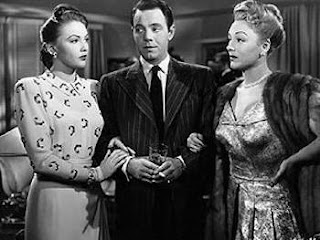 |
| Louis Hayward, Joan Leslie, 'Repeat Performance' (1947). |
"Repeat Performance" (1947) asks whether experience prepares us to avoid mistakes we make, and Sheila does her level best to do just that by traveling to different locales and avoiding certain people. She reasons, quite sensibly, that if you break the chain of events leading up to an unfortunate incident you can nip the mishap in the bud. But, it turns out, fate is a stubborn thing.
Things began to sour last year when she and Barney traveled to London, so she insists that they go to California instead. She never tells Barney about the strange phenomenon she’s been experiencing, instead she confides in her neighbor, wisecracking poet Edward Edwards (Richard Basehart). However, try as she might to prevent them, events find a way of recurring. Sheila tries to stop Edwards from being committed to a mental institution as he had the previous year. And Paula Costello (Virginia Field), playwright and first-class home wrecker whom Sheila tries to ban from her residence, makes a grand appearance much to Sheila’s horror and Barney’s delight.
 |
| Joan Leslie, Louis Hayward, Virginia Field. |
We begin to understand how Sheila fell for Barney — when he turns on the charm he’s quite persuasive. In fact the two of them share some sweet moments together. But as his true character comes out, that of the failed, bitter playwright, we realize that he’s turned into a mean, womanizing drunk. Sheila tries to fix their relationship but it becomes evident that she’s wasting her time.
“Repeat Performance” is an outlier in the film noir canon, with its supernatural bent that conflicts with the earliest examples of noir, which lean toward hyper realism and rough-hewn characters who often inhabit downscale settings. Sheila and Barney are sophisticated New Yorkers and part of the upper middle class. What makes their story similar to those of other iconic characters in film noir is the palpable presence of fate. Invisible forces typically send these anti-heroes to ruin. You can change the events that lead to ruin, but you can’t change human nature, the film seems to tell us.
As it turns out, the do-over does in fact change the story’s outcome in a significant way as the hand of fate re-shuffles the deck. While you can’t drastically alter human nature, a few nips and tucks can make a world of difference.
Sidebar:
We’re lucky to have a restored copy of “Repeat Performance” available on Blu-ray, courtesy of The Film Noir Foundation, UCLA and others. A 2007 screening of the film with an appearance by Joan Leslie was scheduled, and it was discovered that a 35mm print had deteriorated, so the foundation, the university and others coordinated the restoration. As with Sheila Page, an intervention can change what seems to be an inevitable unfortunate outcome.
If you don't want to spring for the Blu-ray you can watch a well-worn print of it here on YouTube.







